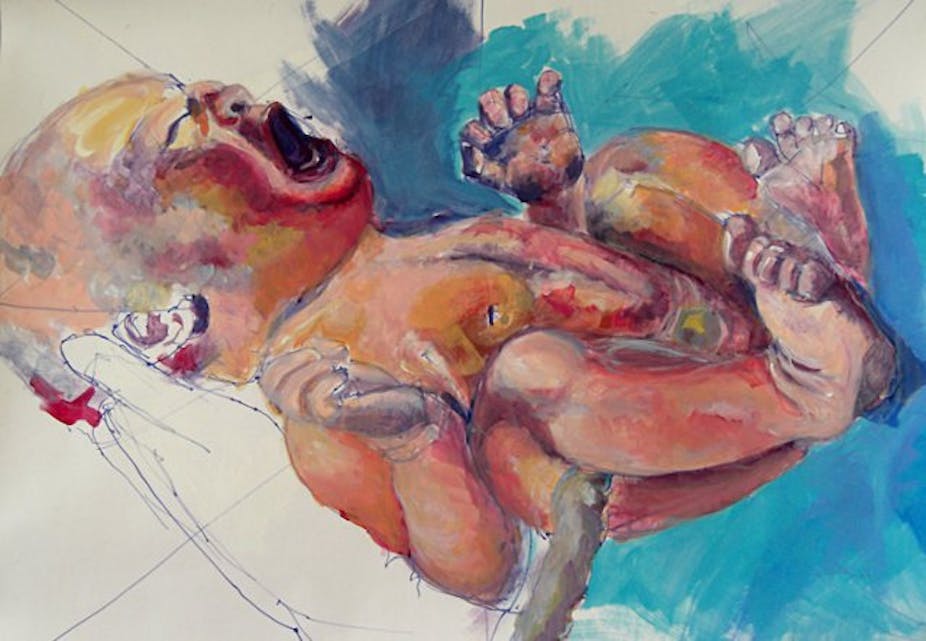We’re fortunate to live in a society where robust evidence forms the basis of the information health-care professionals provide to patients – and home birth should be no exception. But the evidence about the risks of home births and the relative safety of hospital-based births is too often ignored by home birth advocates.
Women need clear and accurate information about the risks of different birthing environments. As an obstetrician of 30 years, I have these discussions with pregnant women and their partners every week. And many are surprised to learn that giving birth at home is far more risky for their baby than a planned hospital birth.
Stark reality
A 2010 study by Kennare and colleagues confirmed previously published Australian evidence that giving birth at home increases the risk of a baby dying during childbirth.
The authors reviewed the outcomes of 1,141 planned home births in South Australia from 1991 to 2006 and found they were associated with a seven-fold increase in the child or fetus dying compared with a planned hospital birth. The risk of fetal death due to asphyxiation was 27 times higher.
The same study noted that in the period 1991 to 2006, the incidence of fetal death in labour due to asphyxia halved in South Australian hospital births compared with the outcomes recorded for 1976 to 1987. But there was virtually no improvement for planned home births over the same study period.
Rates of interventions such as caesarean section and instrumental delivery were lower in the planned home birth group. But this isn’t surprising, given that women who are higher risk of complications are more likely to require interventions and will therefore have a planned hospital birth. This wasn’t accounted for in the study.

Safety claims
Despite the evidence of the risks of home birth, advocates continue to cite international evidence of its comparative safety.
A 2009 Netherlands study led by de Jonge, examined 321,307 women who planned to give birth at home and 163,261 who intended to give birth in hospital. The study concluded there were no significant differences to perinatal mortality (the risk of the child dying) between either group – and this is the message promulgated by home birth advocates.
But when you closely examine the study you see that in the self-selected home-birth group, more of the women were: 25 years and older, of Dutch origin, of medium to high socioeconomic status, more likely to have had two or more children previously and more likely to give birth at 41 weeks gestation. Given these factors put the women in this group at low risk of complications, you’d expect this group to have better outcomes than the hospital birth group, who were at higher risk.
The authors reported that the number of babies who died or were admitted to a neonatal intensive care unit was the same in both groups: seven for every 1,000 births. The equivalent Australian statistics for low-risk women delivering in hospital is between 2.2 and five for every 1,000 births – this is quite a contrast and hardly an endorsement of obstetric practice in the Netherlands.
It must also be noted that maternity services in the Netherlands are set up to meet the demands for home births. Transport is good and distances are short if women need an emergency transfer to hospital. The same advantages are not available in all places in Australia. And if local services aren’t available for quick transfer, the risks of home birth increase.

Comparing risk
Last month, the Royal College of Obstetricians and Gynaecologists released the long-awaited findings of the National Perinatal Epidemiology Unit’s Birthplace in England cohort study.
This study compared the safety of birth planned for healthy women with straightforward pregnancies in four settings: home, freestanding midwifery units, “alongside midwifery units” (midwife-led units on a hospital site with an obstetric unit) and obstetric hospital units. All the women were classified as having a low risk for complications.
The overall incidence of adverse outcomes during childbirth was 4.3 for every 1,000 births. For first-time mothers planning to give birth at home, there were 9.3 adverse events for every 1,000 births and a 45% transfer rate to an obstetric unit.
For women having their second baby there was no significant difference in adverse outcomes between all sites but of the women planning to have home births, 10% to 12% were transferred to other sites.
So my advice to women planning to give birth is – look at the evidence. Even if you fall within the low-risk category, home births pose an increased risk to your baby, particularly in your first pregnancy.

